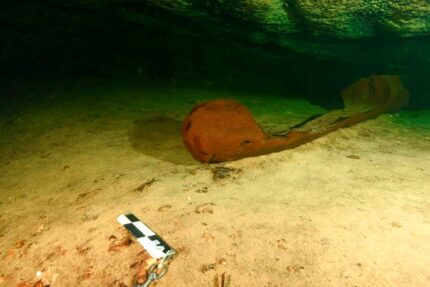An intact Maya canoe more than a thousand years old has been discovered in the Izamal cenote in the Mexican state of Yucatán. The canoe is 1.6 meters (5’3″) long, 80 centimeters (2’7″) wide and 40 cm (1’4″) high. Its style indicates it dates to the Terminal Classic period (830-950 A.D.), the final century before the Maya collapse.
The canoe was discovered during archaeological rescue work preceding construction of the section of the Maya Train that runs from Izamal to Cancun. The find site drew the attention of archaeologists because it has three bodies of water — the cenote, a well and a rejoyada (a deep valley) — which were of great religious significance to the Maya. Mexico’s National Institute of Anthropology and History (INAH) dispatched underwater archaeologists to explore and document the sites.
They actually found the canoe while they were on a decompression break. One of the team noticed a dark spot on the stone wall about 16 feet below the current water level. It was an ancient water line that marked the spot of the water level way back when. They followed up after the break and found a cave at the level of the ancient water mark. Inside the cave was a hardwood trunk, cut out to make a platform type canoe. This small vessel could have been used as a water carrier to scoop water out of the cenote, or it could have been used to carry offerings during rituals.
This is the first time a canoe of this type has been found complete and in such excellent condition in Maya territory. Previously only fragments of the boats and their oars have been recovered.
The preliminary date will be confirmed or denied next November with a dendrochronological analysis performed by experts at the Sorbonne University in Paris. This study will also determine what kind of wood the canoe was carved from.
Likewise, a borehole will be made in the sediment that is under the canoe, in order to define the stratigraphy of the environment and possible additional elements; as well as photogrammetry studies to obtain a 3D model of the canoe, which helps in its study and virtual dissemination and that facilitates the creation of replicas that can be integrated into museums in the region, such as the Museum of Underwater Archeology, Fuerte de San José el Alto, in the city of Campeche….
